I am almost eighty, an age when one begins to think about what one has done, what one has accomplished in life. So, I have been looking back on my forty-year career as a writer about labour and social movements. During this time, I have written principally about the importance of democracy in the labour movements, in society and in politics. I have written about ordinary working people’s attempts to take control over their workplaces, their labour unions, and of the political parties in which they became involved or created. I explore how ordinary people often ran into the power of the bureaucracies of unions, parties or the state, whether in the United States, Mexico, Nicaragua, or Indonesia, bureaucracies that frustrated their desire for control of their own lives.
I would never have undertaken to write on the movement and the question of bureaucracy had I not become a union activist. Like all American leftists of my generation—the Generation of 1968—I am indebted to the African American civil rights movement which sparked all of the movements that followed: anti-Vietnam War, feminists, LGBT, and the rank-and-file labour movements of the late 1960s and early 1970s. The Black movement broke out of the repressive atmosphere of the Cold War and the anti-Communist crusade of McCarthyism. It provided us examples of the struggle for democracy, justice, and freedom. It transformed our consciousness, set us off on various campaigns and projects, and provided us with both old and new problems to think about, to discuss, and to write about.
I write here about the vicissitudes of writing and publishing books. While I conceived and developed some books on my own, other books were proposed to me by organisations that asked me to undertake to write a book they needed or by individuals who connected me to a publisher. Several of my books were written in support of some labour organisation or movement—for Teamsters for a Democratic Union, for Labor Notes, for the Authentic Labour Front of Mexico, for the Front for Indonesia Workers’ Struggle, or for Nicaragua’s people—to educate others about their struggles and encourage solidarity. This essay is about how my books came to be written.
A Brief Autobiographical Note
Since I didn’t begin writing until I was about forty, I think that I should begin this retrospective look at my work by discussing how my experiences informed my later intellectual work. I was born into a working-class family in Chicago on 9 August 1945, the day the United States dropped the second atomic bomb on Nagasaki. My father worked in the produce department and my mother was a cashier at the Hyde Park Co-op Grocery Store, the most successful cooperative in the United States at the time. My father’s family of Dutch bakers were socialist pacifists, while my Irish American mother based her loyalty to the labor union movement on her own experience working in factories, since she was fourteen. My parents divorced when I was eleven years old and my mother moved to the San Diego area of California with me and my sister, where our family fell into a period of real poverty for a few years. I finished high school in 1963, went to Southwestern Community College in Chula Vista, then to San Diego State, graduating in 1968, and a year later went to the University of California at San Diego (UCSD) where I studied literature with Fredric Jameson. I also sat in on Herbert Marcuse’s undergraduate lectures on Marx and, on one occasion, convinced him to lead a discussion of the Paris Commune for the local chapter of Students for a Democratic Society (SDS) of which I was a member.
Taking a break from my graduate studies in literature at UCSD, I went to Humboldt State College in northern California where, for one year, I taught English literature. There I met Walt Contreras Sheasby, a member of the International Socialists (IS), who gradually recruited me by providing me with some of the group’s writings. I read Hal Draper’s pamphlet The Two Souls of Socialism and became convinced of the IS’s “third camp socialism,” that is, of opposition to both capitalism and to Soviet Communism, two class societies both equally oppressive and exploitative and both imperialist. I was attracted by the IS slogans: “Neither Washington nor Moscow. For International Socialism” and “The Free world is not free, and the Communist world is not communist.” I also read Stan Weir’s pamphlet, A New Era of Labor Revolt and was convinced that, as he suggested, something important was beginning to happen in the US labour movement where rank-and-file workers were challenging their union officials and employers.
After a year at Humboldt State, I returned to UCSD, but, by then, had become much more interested in the anti-war movement and the left than in my studies. I helped to form a small IS chapter that engaged in strike support Already a supporter of the United Farm Workers (UFW) then organising agricultural workers in California, we joined boycott picket lines at grocery stores, and also participated in strike support at a tomato ranch. We also supported a Greyhound Bus lines drivers’ strike. Then, in 1970, I left UCSD without finishing my Ph.D. programme in literature and moved to Chicago as part of the IS project to get industrial jobs and join unions and organize in the labour movement.
Intellectual Influences and Milestone Events
While intellectuals often talk about the professors who influenced them, it was not my professors so much as leftist thinkers who provided my intellectual-political formation. In the period from 1969 to 1972, under the influence of the IS, I read not only many classics of socialism—Marx and Engels, Rosa Luxemburg, Lenin, and Trotsky—but also the founders of the IS’s tradition, Max Shachtman and Hal Draper. The writings of Trotsky and Shachtman dealt in large measure with the rise of Joseph Stalin and the bureaucratisation of the Communist Party and the Soviet state. These writing gave me some basic methods for analysing the rise of a bureaucracy that originally came out of the labour movement and the socialist left. This reading later influenced my own writing on the Mexican labour movement, the Teamsters’ union, and the Nicaraguan government.
As we in the IS prepared to enter the labour movement, we also read everything we could find on the unions, but particularly important were Sidney Lens’ Left, Right and Center, an analytical history of US labour; Art Preis’ Labor’s Giant Step, about the rise of the CIO; C. Wright Mills’ New Men of Power, about the rise of the new labour bureaucracy within the Congress of Industrial Organizations (CIO); and Burton Hall’s Autocracy and Insurgency in Organized Labor, which discussed both the contemporary labour bureaucracy and the rebellions against it. About the time we entered into our organising effort, Farrell Dobbs’s books, Teamster Rebellion, and soon after three others, all dealing with the role of the Trotskyists in organising the Teamsters in the 1930s were published, and we also studied those.
Not only our reading but current events were affecting us. We had already been deeply affected by the civil rights and anti-war movement, but now the labour movement was getting our attention. The late 1960s and early 1970s saw one of the biggest labour movements in the United States since the 1930s. There were strikes, both official and wildcats, by auto workers, postal workers, communications workers, and Teamsters, among others. The US Bureau of Labor Statistics explains:
Strike idleness in 1970, increasing 55 percent from the 1969 level, amounted to 66.4 million man-days, the highest level since 1959…. Strikes beginning in 1970 totaled 5,716, the highest annual level ever recorded. Although a comparable number of strikes began in 1969 (5,700), the number of workers involved in stoppages in 1970 rose by 824,000, or 33 percent. Average duration for strikes ending in 1970 was 25.0 calendar days, an increase of 2.5 days from the previous year and the highest for any year since 1947.
At this same time, Black workers in the auto plants organized the Dodge Revolutionary Union Movement (DRUM) and later the Congress of Black Workers, organising protests and wildcat strikes against both the auto companies for their racism and against the UAW for its failure to represent Black workers. Mexican American workers in California created the United Farm Workers and struck many large California growers. Teachers and other public employees walked out in illegal strikes in cities around the country that won them the right to unions and collective bargaining. And, in the United Mine Workers, a rank-and-file movement called Miners for Democracy drove the murderer Tony Boyle out of the presidency, took over the union, and strove to create a new more democratic and militant union, a process we followed closely. Several IS, members, but, in particular Kim Moody, analysed these developments in our internal bulletins, our newspaper, and in the journal New Politics.
My Experience as a Working-Class Activist
In 1971, as part of the IS “industrialisation” programme, that is our plan to get jobs in industry, I arrived in Chicago, at that time with a companion and our two children. I first found a job as a librarian at the Illinois Housing Development Authority, but soon quit to take a job at the US Steel Gary Works plant, first as a labourer and then as a motor inspector apprentice. A few other IS members got jobs there too, but they were in a different faction that soon left the group. And the job at Gary Works was too far from my home in Chicago and I was not prepared to move my family, so I quit.
My companion already had a job as a social worker at the Cook County Department of Public Aid (CCDPA), and needing work, I also became a CCDPA employee and a member of the Illinois Union of Social Service Employees (IUSSE), then a vibrant, democratic, militant, independent union allied with the local chapter of the National Welfare Rights Organization. There was tension between the Black and white workers in the workplace and the union, but also common objectives, and there were always union activists and three or four people from different far-left organisations, so the meetings were quite lively.
The trucking industry was one of the focuses of IS work, so, in 1974, I quit my job at Public Aid, went to truck driving school, and then, after failing to find work at one of the big national trucking companies that we preferred to work at, I took a job at F. Landon Cartage, a small local cartage company with perhaps 50 workers. I became a member of the Chicago Truck Drivers’ Union Independent that negotiated its contracts with the Chicago Teamsters. The IS created a division, called “a fraction” that coordinated our work in the Teamsters which was at the time controlled politically by Richard Nixon and, to a large, extent financially and organisationally by the Mafia. We were engaged in organising a rank-and-file group that would have to fight simultaneously against both the trucking companies and the Teamsters corrupt and venal bureaucracy.
I met the union labour bureaucracy in the flesh in the Chicago Truck Drivers’ Union (CTDU) of which I was a member. My union business agent was an Irishman whose name was Costello, and, strangely enough, he wore a dark suit, an overcoat, and a Homburg hat when he arrived at our barn in a chauffeured black Buick. Passing us by without a word, he went directly into the office to talk with the terminal manager. When he came out, he told us, “Don’t rock the boat. You’re lucky you’ve got a job.” And he left.
I eventually spent six years involved as an activist in the Teamsters’ union and was a founding member of Teamsters for a Democratic Union. It was, for me, a truly formative experience where I had an opportunity to work with a socialist team to put our principles and theories into practice. A series of personal issues—a broken leg, a back injury, and a divorce—led me to leave trucking in the early 1980s, though, no doubt, part of my decision was also based on the declining labour activism, the collapse of much of the far left, factional splits in the IS, and the increasingly conservative political atmosphere: Ronald Reagan was elected president.
After leaving the trucking industry, over the next few years I was involved in various other worker organising projects. Working as a reporter at the historic Black newspaper The Chicago Daily Defender in 1980, I and another reporter attempted to organize the staff into the Newspaper Guild. The company fired me, though, a year later, with the Guild’s support, I won my National Labor Relations Board (NLRB) case. The Defender was forced to post a notice that they had violated the law, furnish me back pay from the day I was fired, and allow me to return to work, which I did for one day to make the point.
Meanwhile, no longer working as a reporter, I was hired by a not-for-profit community group, the Organization of the North East, and became the founding organiser of El Comité Latino, a group made up of Spanish-speaking renters in the area. Later, I also worked as a labour staff person for short campaigns of a few months for public employee unions—the Cook County Hospital House Staff Association (HSA) also in Chicago, the American Federation of State County and Municipal Employees (AFSCME), also in Chicago, and the American Federation of Teachers (AFT) at UCLA in Los Angeles. While in in LA, I worked too for a labour-community coalition called Jobs with Peace. In the early 1980s, I had meanwhile married Dr. Sherry Baron, who had been the president of the HAS when I worked for that union, and we then spent the next couple of decades raising our two boys, while continuing our political activism, though at a lower level. So, now let me turn to my intellectual-political work.
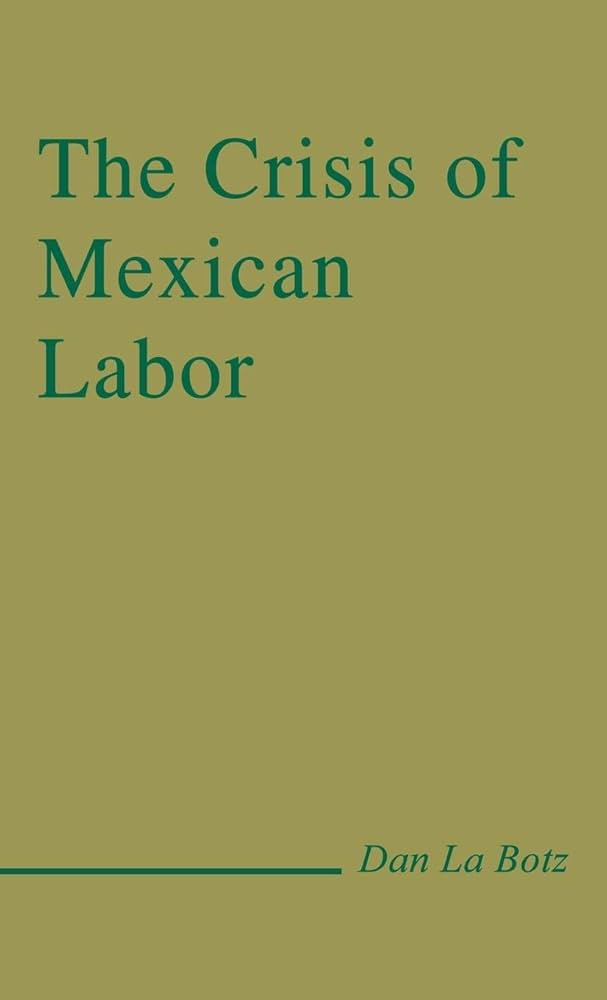
The Crisis of Mexican Labor
My first opportunity to study a national labour movement in depth came when my wife and I spent a few months in Mexico in 1985 where she worked in an environmental health institute and I worked as a free-lance journalist writing for The Mexico City News. Every morning, I would go to the Zócalo (Plaza de la Constitución) in Mexico City where nearly all important social and workers movements eventually appeared to protest at the National Palace or Secretary of Education, sometimes camping out in the patio of the National Cathedral or on the plaza. So, I had the opportunity to talk with dozens of workers, to interview union leaders, and then could follow up with interviews with employers or government officials. In this way, I learned both the language of government bureaucrats, politicians, and employers and the workers’ own way of talking about their work-life situations. I accompanied their marches, visited their hunger strikes, occasionally witnessed police repression against the workers.
One experience was particularly enlightening. The earthquake on 19 September 1985 that had occurred just before we arrived had destroyed over 250 buildings and killed 5,000 people in the centre of Mexico City. The government, while telling people it would come to their rescue, did virtually nothing to help, so people had to undertake to rescue their own families and communities. Particularly hard hit was San Antonio Abad, the name of a street and a small neighbourhood in the centre of the city filled with garment shops employing hundreds of costureras, that is, seamstresses. It was an industry in which there were either corrupt government-controlled unions or no unions at all. Immediately after the quake, employers sent people to rescue their machinery, even as workers, alive and dead, were still buried in the rubble. The government provided no more help in San Antonio Abad then it did anywhere else. Workers had to fend for themselves. In the midst of the rescue work and the grieving and mourning, a grandmotherly seamstress, Evangelina Corona, began to organise the workers into what became the 19 of September Seamstresses’ Union.
I visited the costureras several times and interviewed Evangelina and others. Assisted by what was then virtually the only democratic union in Mexico, the Frente Auténtico del Trabajo (Authentic Labour Front, FAT), by some leftists and by some feminists, the costureras won the right to a union representation election. When the election was held, I went as a reporter to the election site where I saw gangsters from the government-controlled unions, the “official” unions as they were called, taking out their pistols to threaten the seamstresses, telling them to vote for a government-controlled union. Still, despite the threats, the seamstresses voted for their independent union and won. While I had many other experiences with Mexican workers at that time, that was the most dramatic.
While working as a reporter in Mexico and carrying out these interviews, I had also acquired a small library of twenty or thirty books on the history of the Mexican labour movement that I studied. Sherry and I moved to Los Angeles in 1987 and there, while keeping one eye on my newborn son Traven, I sat down and with my little library of Mexican labour histories and my notes and my newspaper stories I wrote my first book, The Crisis of Mexican Labor (New York: Praeger, 1988), a history of Mexican labour from its origins in the 1910s to the mid-1980s.[1] The most important thing I learned in writing this book was that, unlike US labour unions that tend to be dominated by the corporations they organise, giving rise to what we call business unionism, the Mexican labour unions had been dominated by the state, or, to be clear, by the state-party. The Institutional Revolutionary Party that had arisen out of the Mexican Revolution of 1910-1920, founded in 1929, controlled all of the major labour federations. Any fight with any employer public or private therefor also entailed a fight against the ruling-party of the Mexican government. There was nothing novel in the thesis of my book, other scholars had come to that same conclusion, but I laid it all out in a 180-page book written in popular language, without either much scholarly or leftist jargon. Let me jump out of chronological order here to explain how The Crisis of Mexican Labor led to other projects.
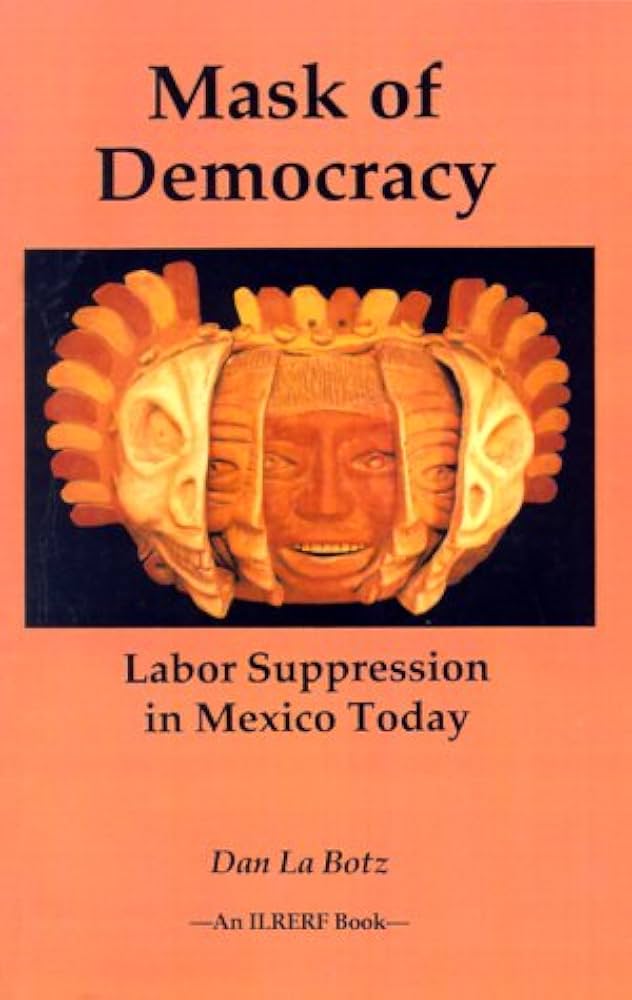
Mask of Democracy
In 1990 or early 1991, I got a phone call from a man named Pharis Harvey, the director of International Labor Rights Education and Research Fund (ILR). He said that he had read my book The Crisis of Mexican Labor and that he wanted me to go to Mexico for his organisation to do research and to write a report to influence the US congressional debate over the North American Free Trade Agreement (NAFTA) then being proposed as a kind of free market for Canada, the United States, and Mexico. He wanted me to write about Mexican workers’ rights or the lack of them. I was at the time a graduate student in a Ph.D. programme in the History Department of the University of Cincinnati, I had a wife, a young child and another on the way, but it seemed like a good opportunity. My wife Sherry agreed, and I convinced the History Department to allow me to take a semester leave for this project. Harvey said that ILR would pay for modest expenses, but that there would be no salary for this work.
A few years before, I had met and become friends with Ricardo Pascoe Pierce, a Deputy (Congressman) in the Mexican legislature for the Revolutionary Workers’ Party. When I arrived in Mexico City, I went immediately to meet with him, and he told me that I should talk with his friends Arturo Alcalde and Berta Luján who would be able to help me. We went together to their house where he introduced me. Arturo was a labour lawyer who represented Mexico’s beleaguered independent and democratic unions. He was also a leading figure in the National Association of Democratic Attorneys (ANAD) involved on many fronts in fights for civil liberties and workers’ rights. Berta was one of the three co-presidents of the Authentic Labour Front (FAT), the most important of the country’s independent unions. The two of them gave me a brief overview of the persistent struggle by Mexican workers to exercise their rights. Arturo then went to another room and came back with a tall stack of book and documents about Mexican labour law, a stack so tall that when I picked them up, I had to hold the top of the stack with my chin. “Read these,” he told me.
Arturo prepared for me a list of labour lawyers around the country who were part of ANAD and defenders of workers’ rights. Berta introduced me to or gave me contact information for other leaders and activists in the FAT that I could interview about their experiences. I began by interviewing workers in Mexico City and cities in the surrounding Valley of Mexico and then, taking trains and buses, I worked my way north to Coahuila and Chihuahua. When I knocked on the law office of one of the attorneys, they would welcome me, talk with me, and then introduce me to the workers they were representing, sometimes right there in their waiting rooms. I interviewed both the lawyers and the workers. I also met some FAT organisers in mining and fishing and a Catholic priest who was helping rank-and-file steel workers. I eventually interviewed scores of workers, lawyers, and others knowledgeable about workers’ rights, more than 200 people altogether. My friend Ricardo Pascoe kindly asked his secretary transcribe my interviews, saving me many hours of work.
While still in Mexico City, I went to Prodata, a leftist clipping service that clipped articles from many newspapers throughout the country, and I had them clip and assemble for me articles from the most important newspapers, arranged in chronological order, about various industries—telephone, steel, mining, etc. I also bought or copied the books that Arturo had recommended to me and other recent books on labour. With these resources—another little library of books on Mexican unions, and with my interviews and the Prodata clipping books, I returned to Cincinnati and wrote Mask of Democracy: Labor Suppression in Mexico Today.
An early draft of the book was distributed as a report to all US Congresspeople. Pharis Harvey arranged to have Matt Witt, an experienced American labour activist who had studied Spanish and spent some time in Mexico, edit my book for publication, which greatly improved it. Without my knowledge, Harvey also had former Secretary of Labor Ray Marshall write the introduction to it, discussing how the United States could use trade restrictions to try to improve labour standards of its trading partners. The blurbs on the back of the book came from Marshall and from Congressman George Brown. Harvey and ILR made sure that Mask of Democracy was discussed in various government hearings and in the Congressional debate.
I also testified as an expert on Mexican workers conditions and the author of the report in front of various committees. In one such testimony I summarised my book’s conclusions:
In brief, the conclusion of my investigation was that Mexican workers are denied their fundamental labor union rights as specified in the Mexican Constitution and in Convention 87 of the International Labor Organization to which Mexico is signatory. Mexican workers do not enjoy the right to join labor unions of their own choosing, they do not have the right to strike, and they do not have the right to bargain collectively.
In fact, the Mexican labor union movement (at least 90 percent of it) is controlled by Mexico’s one-party state. The Institutional Revolutionary Party or PRI which, under various names, has ruled Mexico for over 60 years, controls the Congress of Labor (CT) as well as its affiliated labor federations such as the CTM, the CROM and the CROC. The Mexican labor union system bears many similarities to the state-controlled unions which existed in the Soviet Union or Eastern Europe until recently.
Those unions which are not controlled by the Mexican one-party state, are company unions (sindicatos blancos) controlled by the employers, such as the Monterrey industrial groups. There is a very small independent labor union movement, made up of organizations such as the Authentic Labor Front (Frente Autentico de Trabajo), which fights heroically for labor union rights and workers’ democracy in Mexico.
In Mexico, workers who attempt to stand up and speak out for their rights on the job or in the union may be expelled from the union, fired, beaten, or even assassinated. In particular, labor organizers and activists among teachers and agricultural workers suffered many assassinations in the 1980s and 90s. A number of industrial union officials or activists have also been killed in the petroleum industry, the transport industry, and in the automobile industry. Journalists have also suffered a high number of assassinations.
The state and employers’ control of the Mexican labor unions, which has existed for decades, has meant that Mexican workers are among the lowest paid industrial workers in the world. On an average, Mexican workers make less than one-tenth the wages of American workers performing the same work. In many cases they make even less. Mexican workers also labor in some of the most unsafe and unhealthy conditions. The Mexican Department of Labor and the Mexican Institute of Social Security which are entrusted with the protection of workers’ health and safety have incomplete resources, have insufficient staff and inadequate equipment to do their job. Moreover, they are not conscientious or diligent in protecting Mexican workers’ health, because the ruling party does not want it. SEDUE, the Mexican agency responsible for environmental protection, does not keep good records, does not have strong laws and penalties, and in any case does not strongly enforce the laws and penalties which exists.
Simply put: the Mexican government violates the workers’ rights, keeps their wages at starvation levels, poisons their workplaces, pollutes their communities, and lets gangsters shoot them if they demand justice. This is, of course, completely in keeping with a one-party state which does not respect civil and political rights, which murders the members of political opposition parties, and which engages in massive vote fraud.
The NAFTA debate went on for almost two years. In an article in October 1993, The Washington Post quoted from my book:
“Clearly, this relationship between state, party and union limits the freedom of action of the labor unions and of the workers who belong to them,” said labor specialist Dan La Botz in his 1992 book Mask of Democracy. “At worst, it means that the unions are unwilling and even unable to defend their members against the state or to advance the interests of the workers when those interests’ conflict with the interests of the state.
Despite the criticism and pressure of workers, unions, and labour rights activists in Canada, Mexico, and the United States, in November of 1993 the US Congress passed NAFTA.
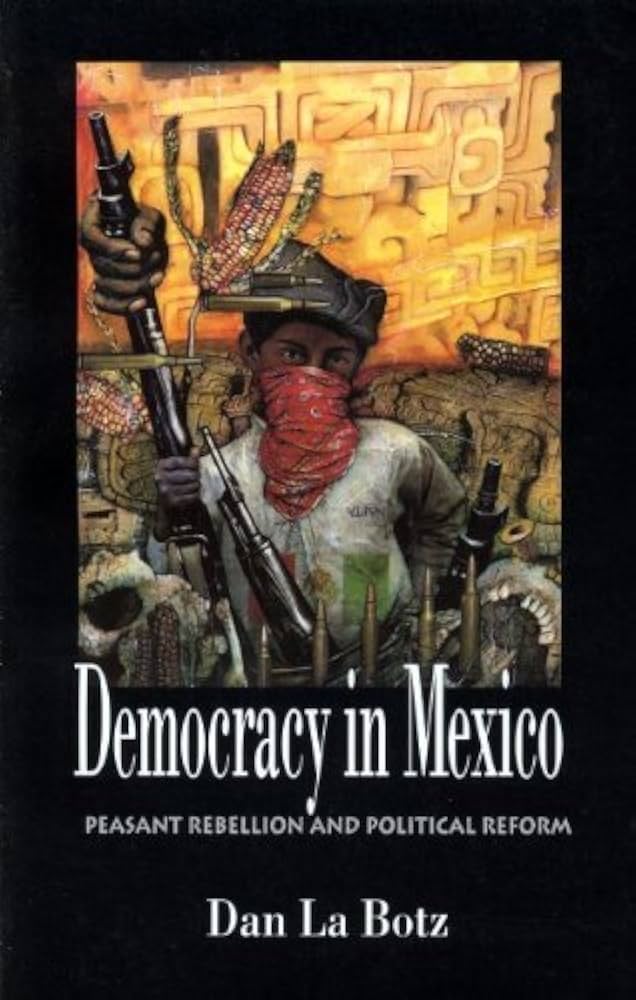
Democracy in Mexico
On 1 January 1994, the day that NAFTA went into effect, the Zapatista Army of National Liberation (EZLN or Zapatistas), headed by Subcomandante Marcos, led an uprising of Mayan peasants in Chiapas, Mexico. The EZLN had suddenly accomplished what many of us had been attempting to do: it threw down Mexican President Carlos Salinas’ façade and revealed behind it the mistreatment of the indigenous, the poverty in the countryside, and as the public rallied to support the rebellion, it showed the many Mexicans who opposed the government. I immediately recognised the significance of this uprising and wrote a pamphlet titled The Chiapas Rebellion: A Political Analysis[2] that was published by Solidarity,[3] the successor to the IS and the socialist organisation to which I then belonged. I went on the road, speaking to Solidarity branches in the Midwest about the Chiapas rebellion.
Several months later, I received an invitation from Cecilia Rodríguez of the National Commission for Democracy in Mexico to join the official delegation from the United States that would attend the Zapatistas’ National Democratic Convention to be held in the Lacondón Forest in Chiapas. I accepted the invitation, travelling by plane to San Cristóbal de las Casas and then, surprisingly, riding in buses provided by the state government rode with other supporters of the EZLN from around the world to the stadium that had somehow been erected in the forest built with recently felled trees. In the evening, I found myself seated by chance next to the great Mexican writer Elena Poniatowska and we chatted as we waited for the convention to begin.
In a theatrical event, in an amphitheatre that had somehow been illuminated by stadium lighting installed by the state electrical company and the government-controlled electrical union, lighting that turned night into day, Subcomandante Marcos talked about the goals of the movement—stopping NAFTA, writing a new Mexican constitution, and liberating the indigenous people of Mexico—as soldiers of his barefoot army carrying wooden mock rifles marched before the crowd. Afterwards, Marcos held a press conference, but there would never be any actual convention. The Zapatistas returned to their redoubts in the jungle and the supporters like myself returned home, or, in my case, went to Mexico City.
I did not understand then exactly who Marcos was and what the EZLN represented. I continued to write about the EZLN and express my questions and doubts about them for the next thirty years.[4] At that time, however, I thought it would be important, to put their struggle for democracy and power against the Mexican one-party state in the broader context of struggles for democracy in various sectors of Mexican society. I would begin with a history of the rise of the Mexican bureaucratic capitalist state from the Revolution to the present. I would discuss the Zapatistas, but also the left-nationalist presidential candidate Cuauhtémoc Cárdenas and his new Party of the Democratic Revolution (PRD), the Mexican feminist and women’s movements, and the workers’ fight for unions in the maquiladoras of the northern border zone. The book would be a historical, geographical, and social panorama of Mexico.
So, I stayed on in Mexico for the national elections held on 21 August, talking with people from various civil society NGOs, visiting election polling places and talking there with election monitors. I talked with political activists from the ruling Institutional Revolutionary Party (PRI), the conservative National Action Party (PAN), the populist social-democratic Party of the Democratic Revolution (PRD), and the Trotskyist Revolutionary Workers’ Party (PRT). I sat and watched the election returns with my friend Ricardo Pascoe, then an advisor to Cárdenas, and as we sipped tequila, we saw Ernesto Zedillo of the PRI with 50 percent of the vote defeat both Diego Fernández de Cevallos of the PAN with 27 percent and Cárdenas with 17 percent. As we knew, elections in Mexico were rigged, but this result was startling and disappointing in any case.
The women’s movement in Mexico was divided between better educated, middle-class feminists, working-class women in urban slums, and poor indigenous women in the country. In Chiapas, I had had an opportunity to see and talk with some Zapatista indigenous women, and in the North, I talked with women from the Urban Popular Movement and women workers from the maquiladoras. While in Mexico City, I arranged to visit and talk with left-wing feminists and middle-class women focused on political reform. I put their experience in the context of the history of both Mexican middle-class feminist groups and working-class women’s movements.
About this same time, Labor Notes held a Cross-Border Organizing Conference in Juárez, Mexico that provided me an opportunity to talk with Mexican and US union officials and activists about attempt to organise the maquiladoras. I had already written at some length about these workers in my workers’ rights study Mask of Democracy, but here I wrote at greater length about different organisations engaged in the fight to organise unions in the maquiladoras.
I tried in Democracy in Mexico to portray all of these movements as different facets of the broad struggle for democracy and for social justice in Mexico. Since I already had a relationship to the leftist publishing house South End Press that had published Mask of Democracy, I took my new book to them. I convinced the publisher to put on the cover of the paperback a wonderful painting by Steven Johnson Leyba. My book was used in courses on Mexican history at various universities.
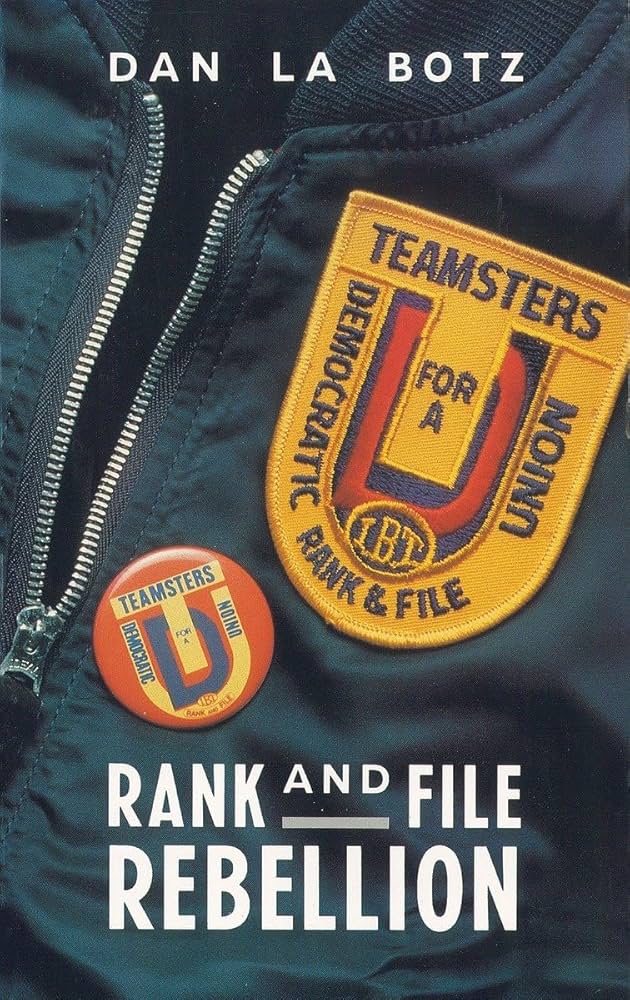
Rank-and-File Rebellion
Just about the time The Crisis of Mexican Labor appeared in 1988, I was approached by Ken Paff, the National Organizer of Teamsters for a Democratic Union, and Mike Davis, then representing Verso publishers, with a proposal to write a book about Teamsters for a Democratic Union. I believe that initially Davis had proposed the idea to Paff and Paff had suggested that I be the author, since we had worked together, and he felt he could trust me. In conversations with Paff, it was decided that in writing the book, we would not discuss the central role of the International Socialists in the organisation of TDU, fearing that that would lead to a backlash of red-baiting that would harm the organisation. I was not entirely happy with that decision, but I thought the book important and writing it a great opportunity for me. I received an advance of $3,000 but no other pay and no other income from the book in the future.
I approached the project that eventually became Rank-and-File Rebellion: Teamsters for a Democratic Union (New York: Verso, 1991) much as I had the book on Mexican labour. I collected every book on the Teamsters that I could find and learned everything I could about the union. Several well-known books, fat tomes, had been written about the Mafia and the corruption in the union, and, while this was an important issue, I decided to keep that element to a minimum since I was more interested in the union’s history, its structure, and its relationship to the employers and the government. I wanted to write about union members’ fight for democracy in the union and the power to confront the bosses, not about crime. My book would be based on history, sociology, and the voice of workers rather than following the careers of various mobsters who had made the word “Teamster” synonymous in the public mind with “gangster.”
In addition to my reading, I also travelled to various cities and made many phone calls and interviewed dozens of Teamster activists from the United States and Canada, about 75 men and women altogether. I interviewed some in their homes, some at TDU meetings, some in person and some by telephone. I always taped the interviews and then transcribed them in full – really tedious work. When I finished an interview, I generally sent it to the person I had talked with to check it and make sure I hadn’t misunderstood anything. I also asked those I interviewed to provide me with any documents they had, and some had treasure troves of company or union documents or records of their own grievances. One even had an aerial photograph of a plant where there had been a strike.
I would say that I learned two important things from writing this book. The first as that I gained a new appreciation of the role played by a charismatic individual in cohering, motivating, and leading a bureaucratic layer in the union. In this case, of course, that person was Jimmy Hoffa. Hoffa was admired early on as a leader of strikes and later working with the revolutionary socialist Farrell Dobbs, Hoffa learned about union strategy and tactics. He used that knowledge brilliantly in bringing the union’s freight carriers into a common agreement with the employers, the National Master Freight Agreement. But then he also made alliances with Mafia figures like Tony Provenzano and invited Mafia-connected Allen Dorfman in to run the union’s pension funds. As I wrote at the conclusion of my discussion of Hoffa’s career:
While he was a popular and charismatic leader, Hoffa was also a union boss, a dictator who tolerated no opposition. He once screamed in open court that he would kill a man who had testified against him. He crushed local unions that fought for their autonomy and destroyed rank-and-file movements that rose to fight against him. He did it, he said, for their own good. A demagogue who could stir up class hatred without raising class consciousness, Hoffa never helped the Teamster membership to learn to think and act for itself. On the contrary, he imbued in the union membership a sense of dependency. He, Hoffa took all credit, and shouldered all blame. Hoffa organized the union. Hoffa negotiated the contracts. Hoffa took care of the Teamsters until they could no longer take care of themselves. That was Hoffa’s greater crime, greater than his own enrichment at the expense of the members, greater than involving the Mafia in the union, both of which were terrible evils. But worse still, Hoffa gave the Teamster members the appearance of power and the swagger of self-confidence, while depriving them of the only possible source of real confidence, the control of their own union. (p. 158)
In the end, of course, I did have to deal with the Mafia, though still keeping it from becoming the centre of the book. I realised that while we think of the labour bureaucracy in the United States as being principally dependent on the corporations and secondarily regulated by the government, in this case that relationship was considerably altered by the central role played by the Mafia that was engaged in extorting and selling labour peace to some employers and mismanaging and pilfering the pension funds, criminal activities that led to repeated US government investigations and ultimately to the US government intervening and court supervision of the union for years. Other unions, even historically left-led unions such as the United Autoworkers, also succumbed to corruption, but not as quickly and never as violently as the Teamsters and other mobbed-up and gangsterised unions such as the Hotel and Restaurant Workers and the International Longshoremen’s Association.
The book was published in 1990 at the peak of TDU’s influence in the union and just before the election of Ron Carey to the presidency of the union in 1991, a reformer backed by TDU. Paff had arranged to have Victor Reuther, a founder of the United Auto Workers union write the introduction.
Over the years, many Teamster members told me that they had read Rank-and-File Rebellion, enjoyed it, and found it useful. For decades after it was published, TDU organizers and activists continued to recommend the book to new members as an introduction to the movement.
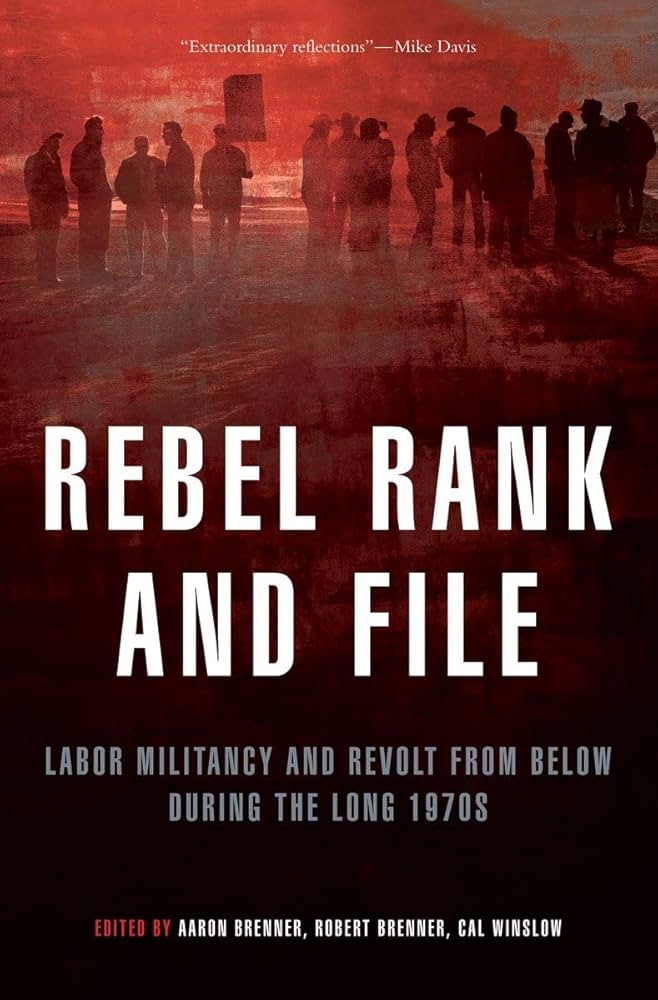
Rebel Rank and File
Again, let me break chronological order to continue with my writing on the Teamsters. Sometime around 2005, the young leftist scholar Aaron Brenner contacted me about writing a chapter on the Teamsters for a book that he, his father the economic historian Robert Brenner, and the leftist academic Cal Winslow, would edit. The title made its subject clear: Rebel Rank and File: Labor Militancy from Below During the Long 1970s (New York: Verso, 2010) All of the authors were experts on the unions in the industry they discussed, and several had been activists in those movements of auto workers, miners, telephone workers or teachers. A few chapters by the editors provided the broader political and social context for those movements. I was anxious to write the chapter on the Teamsters, because I wanted to explain the role that had been played by the International Socialists in organising TDU, a subject that had been excluded from my book Rank-and-File Rebellion.
In preparation for the writing and editing of the book, Robert Brenner arranged to host at UCLA a small conference of about twenty people, editors, writers and a few others most of whom made brief presentations on particular industries and unions, several of which were fascinating, and most of those became chapters in the book. I presented a draft of what became my chapter in the book, “The Tumultuous Teamsters of the 1970s.” In that chapter, I provided a brief overview of the Teamsters’ union, the various rank-and-file groups active in the 1970s, and discussed in some detail the role of the International Socialists in founding TDU. When the book was published in 2010, I was able to join a few other authors for a presentation at the Brecht Center, a leftist education project in New York. With the publication of Rebel Rank and File, containing my chapter on the Teamsters, I felt that I had completed my earlier book, finally giving the true story of our role as socialists in the movement. I believe that the chapter on the “Tumultuous Teamsters” provides many useful lessons for leftists who want to do union work, fighting both the bosses and the labour bureaucracy.
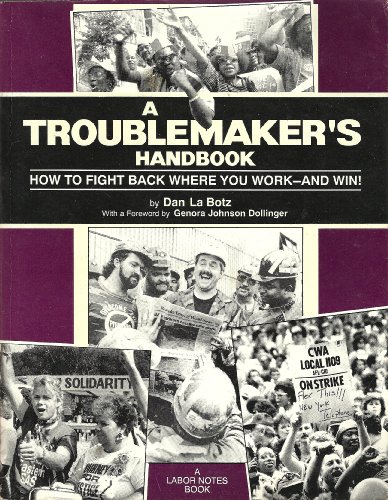
The Troublemaker’s Handbook
Just after the publication of my book Rank-and-File Rebellion in 1990, I was contacted by Labor Notes about writing a book for them. Back in 1978, three of my comrades in the International Socialists, Kim Moody, Jane Slaughter, and Jim West, founded a publication called Labor Notes as a source of information issues and activities in the labour movement and also as an aid to the organisation of rank-and-file movements in the unions. Labor Notes also became the name of the labour-education centre that published not only the Labor Notes magazine, but also pamphlets and books and that organised conferences for union activists. I was then living in Cincinnati; Ohio and I drove up to Detroit for a meeting with the staff about the book.
Rand Wilson, a very talented union organiser, had initially proposed to Labor Notes the idea of a union organising manual, but he himself didn’t have time to work on it. While his idea was timely, I thought a traditional how-to manual—that is basically a set of instructions—would be uninteresting to write and boring to read. I suggested that, instead of such a manual, we interview the most successful organisers in the Labor Notes network about how they did their organising. The LN staff liked the idea, and it was agreed that I would write the book, and that Jane Slaughter would edit it. Jim West, a fine photographer, would provide photographs and Ellis Boal, a labour attorney would provide legal information. Eventually Genora Johnson Dollinger, the organiser of the Women’s Emergency Brigade during the autoworkers’ strike at General Motors in Flint, Michigan in 1937 wrote the foreword. It was understood that I would undertake this work without pay. The purpose of the book would be to help workers organise themselves, with, without, or against the unions’ officials as the case may be.
Jane and I laid out a plan for the book’s chapters. I spent the next several months interviewing what would eventually be over a hundred workers, men and women of various races and ethnicities, workers in dozens of different industries and unions, some union officials, but mostly union stewards or rank-and-file members. I transformed these interviews into chapters dealing with organising new unions, mobilising the union in the face of employer repression and persecution by union officials, the organisation of strikes and the negotiation of contracts, as well as responding to racism and sexism by the employers or the union, fighting for union democracy and taking power in a union. I also wrote questions for each chapter as a guide for individual readers or group discussion. Each week or so, I would write a chapter and send it to Jane for editing; and, after a while, we held another meeting in Detroit to discuss how to incorporate the legal information and asked attorney Ellis Boal to write those sections. We granted permission to unions, rank-and-file worker groups, and labour studies programmes to reprint sections of the book for free distribution. The book’s format was 8” x 11” so that workers could easily photocopy any page or section and distribute it to their coworkers.
I proposed that the book be called The Troublemaker’s Handbook, to which Jane added: How to Fight Back Where You Work—and Win! (Detroit: Labor Notes, 1991). With that title, the book was published in 1991 and quickly sold out the first printing, within a year or two, 25,000 copies were sold at a price of $17 each, all of which went to Labor Notes. For the next several years, whenever I went to a Labor Notes conference or some other labour meeting, someone would approach me and say, “Hey, I love your book. Thanks for writing it.” One guy said to me, “I keep it right by the toilet and every day when I get up, I take a look at it and see what we might do today.” Is there a higher compliment? In 2005 Jane Slaughter edited Troublemaker’s Handbook 2 to which I and many others contributed. Labor Notes adopted the slogan “Troublemaker” for its educational meetings and for its t-shirts and other paraphernalia.
One never knows exactly the impact of one’s books, so it was very gratifying to learn that Shawn Fain, the reformer who became president of the United Auto Workers’ union, speaking at the Labor Notes Conference in April of 2024 had held up my Troublemaker’s Handbook and called it “my other Bible.”[5] Labor Notes then created a link where one could download the book. Thirty-five years after I wrote it, it had achieved a certain fame among worker activists and people still wanted to read it.
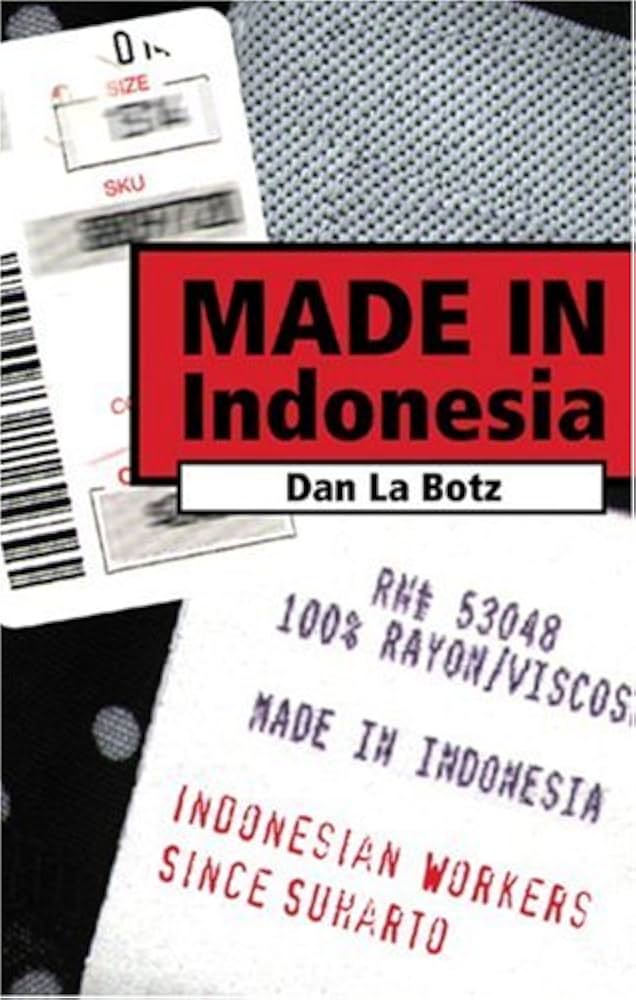
Made in Indonesia
In 1999 and 2000 I was working with Medea Benjamin and company at Global Exchange (GX), which defined itself as an activist human rights organisation. There I became aware of Indonesia’s revolutionary developments, because GX had done work around human rights issues there in the period of the dictator Suharto who fell from power in May of 1998. After writing several books on Mexico, I wanted to do something different, and I also wanted to learn something about Asia. So, I joined an online discussion group on Indonesia. One of its members, historian John Roosa, said he liked my views, but thought that I should go to Indonesia to learn about the country, which he knew well. I applied to the Fund for Investigative Journalism for grants in two successive years to visit Indonesia and do research there for a month or more on each occasion.
John Roosa put me in touch with members of the Partai Rakyat Demokratik (PRD – People’s Democratic Party) and when I arrived in Indonesia in 1999, I visited and interviewed them. Their politics had been formed under the influence of Filipino Maoist organisations. I also visited the AFL-CIO’s American Center for International Solidarity which very kindly provided me with photocopies of their annual reports on labour rights and at one point provided me with a multilingual translator who accompanied me to a meeting at a safe house for Indonesia women labour activists. So, with the help of the PRD and AFL-CIO Solidarity, I visited union halls, met with union leaders, talked to striking workers on picket lines and in meetings.
A particular pleasure of my visits to Indonesia was the PRD introduced me to the great Indonesian novelist Pramoedya Ananta Toer, author of the Buru Quartet, his four great novels, which I had just then read, about the rise of the Indonesian independence movement. A modest, engaging man, surprisingly he talked about how Steinbeck had influenced him. He should have won a Nobel Prize, and one wonders if his history left activism was the reason he did not.
I suppose that it may have been a mistake to undertake researching and writing a book about Indonesia since I didn’t speak Dutch, the language of the imperial power that had dominated Indonesia for three hundred years, and I didn’t speak Bahasa Indonesia, the national language since it won its independence in 1949, nor did I speak any of the many other languages such as Javanese, Madurese, Minangkabau, or Balinese. Though I did pick up some Bahasa phrases, I could neither understand or speak the language, so I had to rely principally on English language books for my historical and sociological research and on translators or English-speaking subjects for my interviews.
I arranged to meet and talk with the principal leaders of the independent workers movement in Indonesia, most important Dita Sari, a leader of the PRD and of its labour organization the Front for Indonesia Workers’ Struggle (FNBI), and Muchtar Pakpahan, head of the Indonesian Workers’ Welfare Union (SBSI – Serikat Buruh Sejahtera Indonesia), both of whom had been imprisoned by the Suharto government for leading strikes. Relying on a few excellent English language histories, I tried to put together Indonesia’s experience under Dutch imperialism, Japanese occupation, and globalisation to show the context of the contemporary labour movement. My linguistic limitation meant that I spoke to more political activists, union leaders, and NGO employees than workers, though I did manage to meet and with the help of translators an interview a number of workers in various industries.
I took my book proposal to South End Press, which had published two of my Mexico books, and I was helped a great deal by editor Anthony Arnove. The book was eventually published as Made in Indonesia: Indonesian Workers Since Suharto (Cambridge: South End Press, 2001). Because I didn’t have the in-depth experience and knowledge that I had in writing my Mexico books, I made mistake, mischaracterising a contemporary political party. Nevertheless, I think it is fundamentally a sound book and I find it is still cited in studies of Indonesian labour.
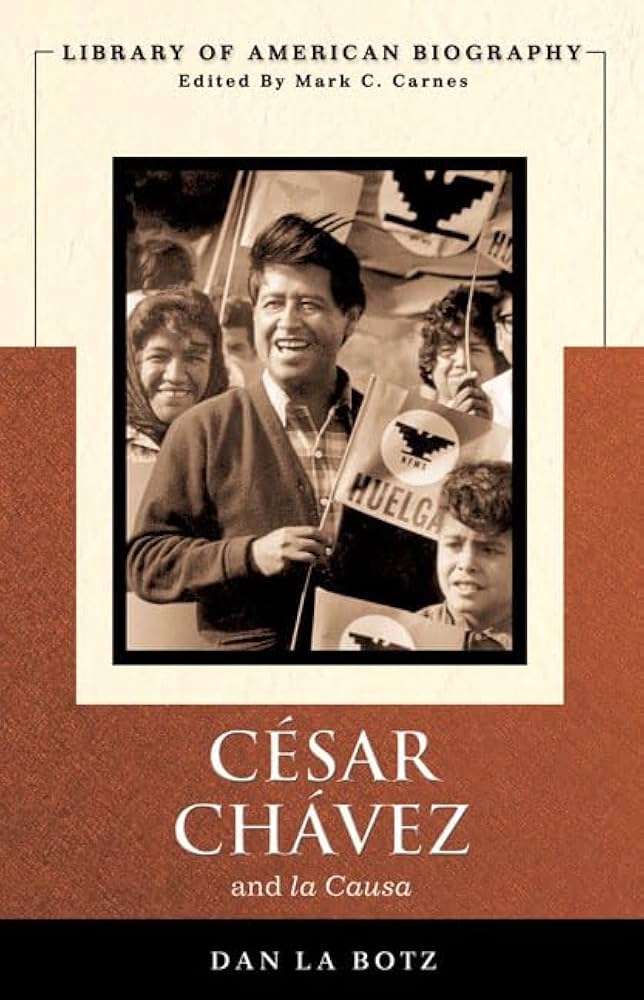
César Chávez and La Causa
In 1998 I had earned my Ph.D. in US History from the University of Cincinnati and began to teach, first as a lecturer at Northern Kentucky University and then as a visiting professor at Miami University in Oxford, Ohio teaching courses in US History and Latin American studies. One day, in 2004, my colleague Alan Winkler, a professor of American History, walked into my office and said, “Dan, I think you should write a biography of César Chávez for the ‘Library of American Biography’, a series for which he had already written a book on Franklin D. Roosevelt. He introduced me to a representative of the Pearson/Longman publishing house who talked with me about the publisher’s conception of the books in the series: relatively short books (under 200 pages) written for first year college students. I signed a contract and went to work on the book.
I already knew a good deal about Chávez and the United Farm Workers (UFW) both from my own personal experience and from my teaching of courses on Latinos in the United States. In the 1960s, I had supported the UFW boycotts and had supported a strike at the Egger-Ghio Ranch in San Ysidro in 1970. And, during my time in the Teamsters’ union, I was aware of the way in which the Teamsters hired thugs and used intimidation and violence against the UFW to try to steal their contracts. I had also in preparing my classes on Latino immigrant history read books and articles about Chávez and the union, but now I set out to read everything I could find. In addition to reading the many biographies of Chávez and studies of the union, I also travelled to Wayne State University in Detroit to use the UFW archives there.
I knew that Chávez was an inspiring figure for many Mexican Americans old and young, but I also knew that he had serious faults. I wanted in my book both to recognize Chávez’s achievements, but also to criticise his failings. Chávez had built a union, led strikes and boycotts, and won some of the first labour contracts for agricultural workers in California. But he had done so by pushing the Filipino workers’ union to the side, promoting Mexican nationalism and the Catholic Church, and he had made the union dependent upon the Democratic Party and government financial support. Within the union, the charismatic Chávez became an authoritarian figure, driving out leftists and repressing his rank-and-file critics. And, after the heroic 1960s and 70s, the union had lost its power, its contracts, and, to some extent, its reputation. Achieving the right balance would be challenging.
I produced a first draft of the book and sent it to the publisher who sent it out to peer review readers, then a second draft and more readers, then a third draft and yet more readers and finally a copy editor. The publisher, altering some suggestion I had made, gave the book the excellent title César Chávez and La Causa (New York: Pearson, 2006). In the end, largely thanks to the many readers and their comments, I produced a balanced book, one of the best I had written, and it began to be adopted by professors teaching courses on Mexican American history. I was delighted. But trouble was brewing.
Just after my book was published in 2006, Jaqueline M. Levy, daughter of Jacques Levy who was author of what was a virtual as-told-to biography of Chávez, had decided to publish a new edition of her father’s book with the title Cesar Chavez: Autobiography of La Causa. My book with its similar title would be a competitor, so, to drive it off the market, she threatened to sue me and my publisher for plagiarism. Like everyone else who ever wrote about Chavez, I had used as a resource her father’s book, something I acknowledged both in the introduction and in the note on sources at the end of the book. When I learned of the suit, I was indignant and angry and sat down and wrote a long response to Jacqueline M. Levy’s attorney rebutting their accusations that that I sent to the publisher, Pearson/Longman. Then I met with one of the firm’s corporate attorneys who told me that he sympathised with my situation, but that, from the point of view of the publisher, a large corporation that published hundreds of books, it was not worth their time and money to fight the suit. So, the company ceased publishing the book. Professors continued to assign the book and students bought used copies online, while one professor in San Diego, much to my delight, published a pirate edition of the book.

A Vision from the Heartland: Socialism for the 21st Century
In 2010 I decided to run as the Socialist Party candidate for the office of US Senator from the state of Ohio at the suggestion of a few friends. There were several reasons for this decision. First, President Barack Obama’s Affordable Care Act had prompted attacks from the right which claimed that this was socialism. Socialism was now on the agenda for debate. This was the first wide public discussion of socialism in America since the Cold War and Joseph McCarthy’s anti-Communist crusade. Second, successful laws suits brought by various minor political parties, had made it easier for candidates of small parties to get on the ballot. So, after meeting with the Socialist Party leadership in New York and consulting with the party’s attorney in Columbus, and with my wife Sherry’s support, I decided to run.
I thought that in addition to doing the usual- fund raising, building a campaign organisation and speaking to all sorts of organisations around the state- I should also write a book laying out my vision of socialism. So, sometimes working in my office at home and sometimes working in the car as my young campaign organiser Michael Cannon drove me around the state, I wrote A Vision from the Heartland: Socialism for the 21st Century (Cincinnati, Ohio: Buckeye Socialist Press, 2020), a 200-page book downloadable from my campaign website. My campaign treasurer, literature professor Reginald Dyck very kindly edited it. My son Reed created the website home for the book, Alexandra Kuzyk designed the book’s cover, and her father Ivan Kuzyk suggested the “Buckeye Socialist” tagline for the log, which I also adopted for the name of the publishing company.
In A Vision from the Heartland, I discussed every aspect of American society – economic, political – and social problems from health, education, and housing, to militarism, war and imperialism, but all with an emphasis on Ohio’s situation. I also dedicated separate chapters to the conditions of African Americans, Latinos, women, and youth (the latter written by Michael Cannon). The book concludes with a chapter titled “A Socialist America” that explains how a socialist America might work. Finally, in the two appendices are my particular platform and the Socialist Party programme. The book is still available today on my Academia.edu website and other sites.
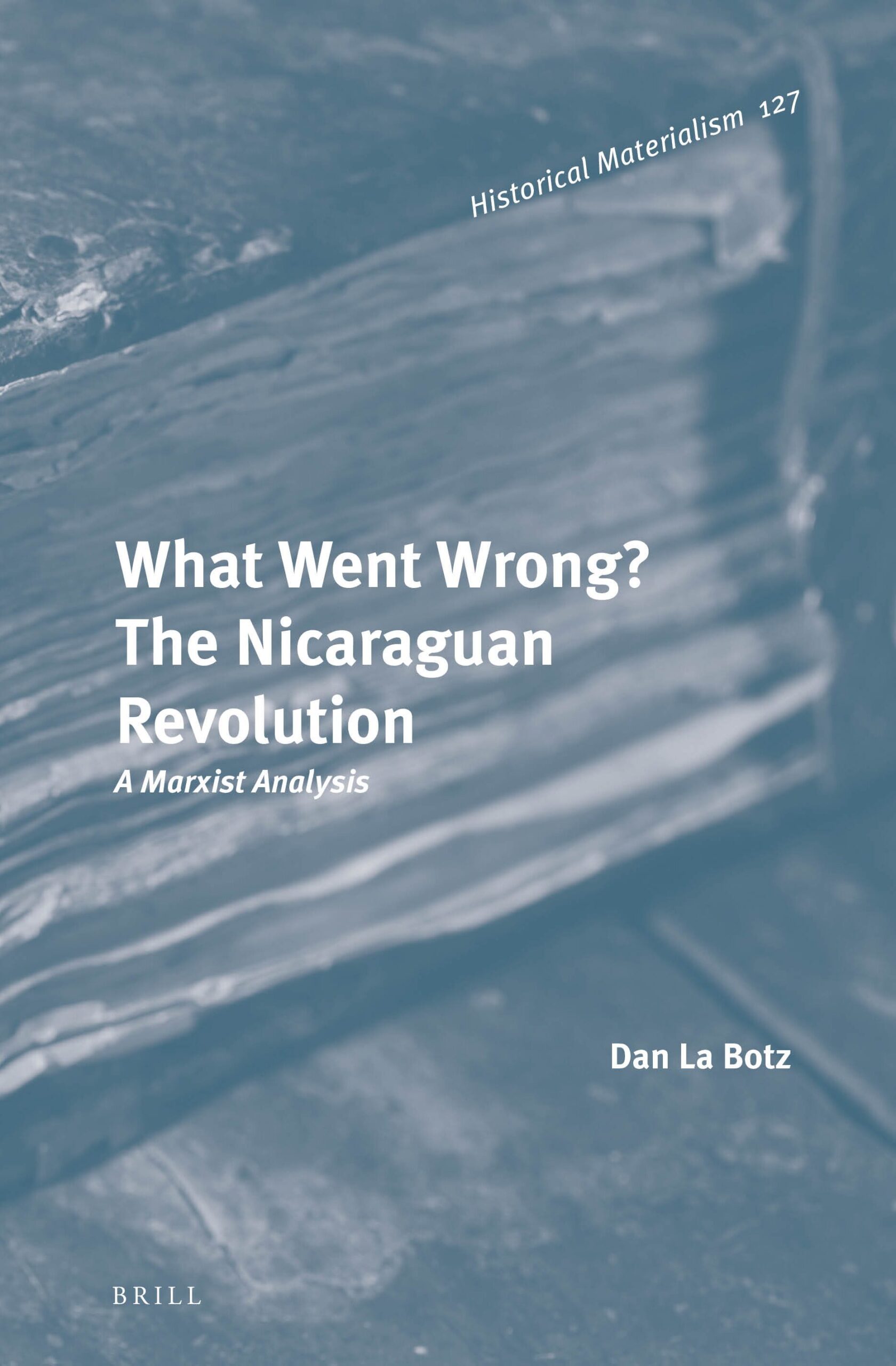
What Went Wrong? The Nicaragua Revolution: A Marxist Analysis
Writing a book is sometimes fortuitous. Sometime in early 2013, my wife Sherry and I went to an Indian restaurant in our Cincinnati neighbourhood for dinner and, while eating, we happened to spy Professor Irene Hodgson of Xavier University at another table. She was someone I had known as a colleague in the field of Latin American studies and as a fellow activist in the Central-American solidarity movement. We walked over to talk to her and looking at me her eyes lit up. “Dan,” she said, “I need someone to take a group of students for a semester abroad in Nicaragua. Would you like to do it?”
I was intrigued by Irene’s offer. Sherry and I and our friend Dr. Bruce Bernard had visited Nicaragua in 1985 during the Sandinista-Contra war, taking medical supplies to a hospital in Estelí. We had, at that time, hitch-hiked through the country, stopping in various cities and rural communities from Managua to Matagalpa talking with all sorts of people. I was teaching at that time at Roosevelt University, and I had written a series of articles about the experience and about how I saw the situation for the school newspaper. I was interested in seeing what had happened to the Sandinista revolution that had once inspired so many, including myself and my friends. So, I agreed and left for Managua not long after.
Irene had set up and run for twenty years a service-learning, study-abroad programme based on her contacts in the Catholic Theology of Liberation movement in Nicaragua. I now stepped into her shoes and guided the students through the programme. While in Managua, students worked in various social service, health, and education programmes during the day while, in the evening, they took classes in literature, history, religion, and with the accompanying instructor or via remote video lectures and discussions. On the weekends and sometimes over four or five days, the programme’s talented drive-guide Martín Castro travelled to cities and towns in other regions of the country. Students met guest speakers from the mestizo world of the Pacific Coast and indigenous and Black People from the Caribbean Coast, social and labour movement activists, priests and lay people, and political leaders of all stripes.
While the students went off to work all day, I soon found an air-conditioned café bookstore called El Literato and began to read my way through the histories and biographies that I found there. Between my reading and our discussions with our guest speakers from leftist priest Fernando Cardenal to conservative businessmen and politicians and feminist leaders, together with the students I gained an overview of the country. At the same time, I observed with my own eyes that the government of Sandinista leader Daniel Ortega had become an authoritarian state, coopting or suppressing the political opposition and repressing the labour and social movements while, at the same time, he supported the business elites and allied with the right wing of the Catholic church. I began to write critical articles on Nicaragua for New Politics, using the pseudonym Michael Kelley, so as not to jeopardise Xavier University’s study-abroad programme.
When I went to Nicaragua, I had not intended to write a book, but upon returning, I could see that it was important to explain that the Sandinista revolution that so many of us had admired had been transformed into a personal and political dictatorship. I wanted to explain what had gone wrong and I thought I now had the knowledge that would allow me to do so. I had already done some writing in Managua, continued in Cincinnati, then wrote more while Sherry and I were staying briefly with a friend in Erlanger, Kentucky, and finished the book in Brooklyn, New York. I wrote what became in fact a 400-page history of Nicaragua from indigenous beginnings, then under the Spanish and British empires, through the independence period, followed by the early nationalist movements of Zelaya and Sandino, through the Somoza dictatorship, to the Sandinista Revolution, then the right-wing era that followed, and finally the return of Ortega to the presidency, his dictatorship and the revolution’s degeneration.
The crux of my argument was that the founders of the Sandinista Front for National Liberation (FSLN), trained in the Nicaraguan Socialist Party (PSN), a pro-Soviet Communist Party, and then adopting the politics of the Cuban Communis Party, had no belief in the importance of democracy in the left, in the labour and social movements, or in society. The FSLN directorate, a handful of men, would hand down to the country what they believed it needed. When Daniel Ortega and other leaders became more authoritarian and turned to the right, there was no way for the party membership or the society to control them.
The hardback edition of What Went Wrong? The Nicaraguan Revolution: A Marxist Analysis, was published by Brill in 2016 and the paperback edition by Haymarket in 2018, just in time for the massive democratic uprising that swept Nicaragua that year. Now living in Brooklyn, I joined the protest in solidarity with the uprisings in front of the Nicaraguan embassy and spoke to large meetings of Nicaraguans in New York City as well as to some smaller Democratic Socialists of America meetings. I followed the protests and their violent suppression by Ortega on the website of New Politics. Unfortunately, Ortega remains in power and the Nicaraguan people have not found the means to drive him out, which if they begin, we socialists should support.
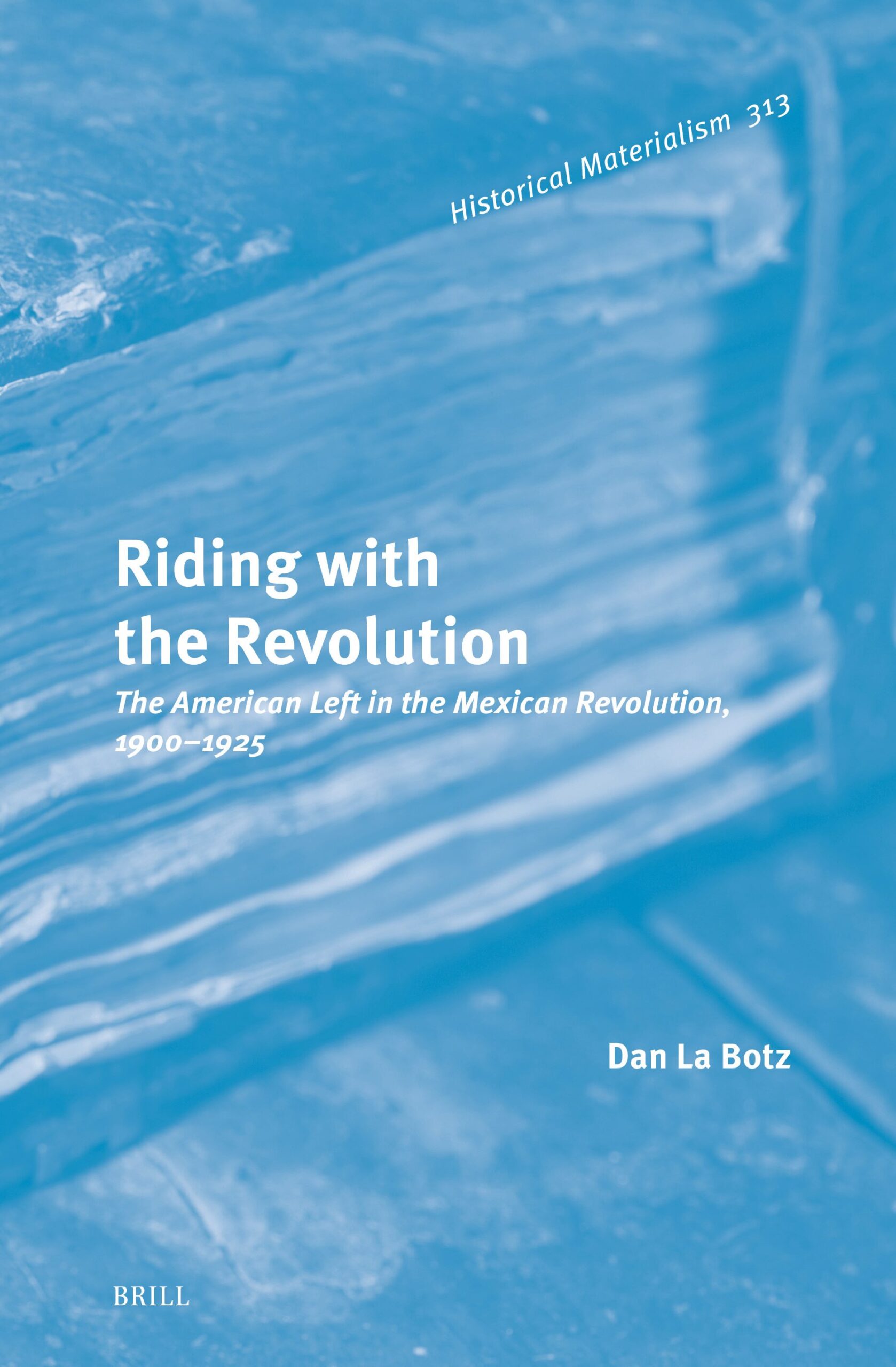
Riding with the Revolution
In the 2010s, I returned to the topic of my 1998 dissertation, that is, the American Left and the Mexican Revolution. I began with the text of my dissertation titled “‘Slackers’: American War Resisters and Communists in Mexico, 1917-1927” which dealt principally with American Socialist and Communists who had gotten involved in Mexico. For the book, I revised and expanded the entire text consulting many articles and books published since 1998. I remained interested in this topic largely because working with the United Electrical Workers Union (UE) the Authentic Labour Front, and as editor and principal writer of Mexican Labor News and Analysis published jointly by those two unions, I had myself, like those Americans who went into the Mexican Revolution, been a leftist involved in solidarity with Mexican unions.
For the book, I added entire chapters, such as one on the Protestant churches in the revolutionary period and the role of the Machinists’ union and Farmer Labor Party. My book, Riding with the Revolution: The American Left in the Mexican Revolution, 1900-1925 (Leiden: Brill 2024), deals with all of the American left organizations in the broad sense: the Protestant missionaries, the Industrial Workers of the World, American Federation of Labor, the Socialist Party, the anarchists in both Mexico and the United States, and the Communist Party. The book is a study in national, translational, and world revolution, attempts that, unfortunately, failed in the mid-1920s. Riding with the Revolution will appear as a Haymarket paperback in 2025.
Riding with the Revolution examines the failure of the American Left of all sorts to have much influence on the Mexican Revolution because of the rise of Mexican nationalism and the new Mexican state. The Left confronted the one-party Mexican state that had begun to emerge in 1917, just around the time the Americans began to intervene and which had cohered in 1924, leading to the last of them being driven out. The Mexican Revolution had led to the creation of a new arrangement of capitalism and to a new bureaucratic state that controlled politics, the unions, and the social movement. That is, my latest book took me back to where I had begun with The Crisis of Mexican Labor back in 1988, that is some 35 years ago.
All of these books mentioned here investigated how bureaucracies of unions, parties, and the state frustrated working people’s efforts to improve their lives and achieve greater power over them. Our society is constituted by bureaucratic organisations—corporations, the government, the military, and the police, labour unions and non-governmental organizations—and they represent a challenge to democracy and to the goals of a just society that can meet people’s needs while living in peace.
Writing is usually an individual process and sometimes a lonely one, but, in my case, it was based on collective thinking and action. I could not have written these books without the guidance of the International Socialists, Solidarity, and the editorial board of New Politics which, for fifty years, provided me with a political compass, nor without the help of the various labour and social movement organiqations that I worked with, nor without the interviews provided by hundreds of workers from the United States, Mexico, Indonesia and Nicaragua. I continue to believe that the solution is democratic socialism—but that goal has been elusive. I am sure that many others will continue to study these problems in the future and to take action for social justice.
[1] I should mention that, during the Cold War, Praeger had been a vehicle for the Central Intelligence Agency, but, by the time I approached Praeger, it had become a regular academic publisher no longer associated with the CIA.
[2] A second edition published later the same year, also by Solidarity, bore the title: Chiapas and Beyond: Mexico’s Crisis and the Fight for Democracy.
[3] In 1986 the International Socialists joined with a few other socialist groups to create Solidarity, now called Solidarity: A Socialist, Feminist, Anti-Racist Organization.
I wrote the first edition of a pamphlet for the group titled Why Socialists Need Organization.
[4] Dan La Botz, “Twenty Years Since the Chiapas Rebellion: The Zapatistas, Their Politics, and Their Impact,” Solidarity, 13 January 2014 at: https://solidarity-us.org/p4082/; Dan La Botz, “At 30, the Zapatistas’ Future is in Question,” Solidarity, February 21, 2024, at: https://solidarity-us.org/at-30-the-zapatistas-future-is-in-question/
[5] Al Bradbury,” Free Download of Shawn Fain’s ‘Other Bible,’ A Troublemaker’s Handbook,” Labor Notes, 25 April 2024, at: https://labornotes.org/2024/04/free-download-shawn-fains-other-bible-troublemakers-handbook

